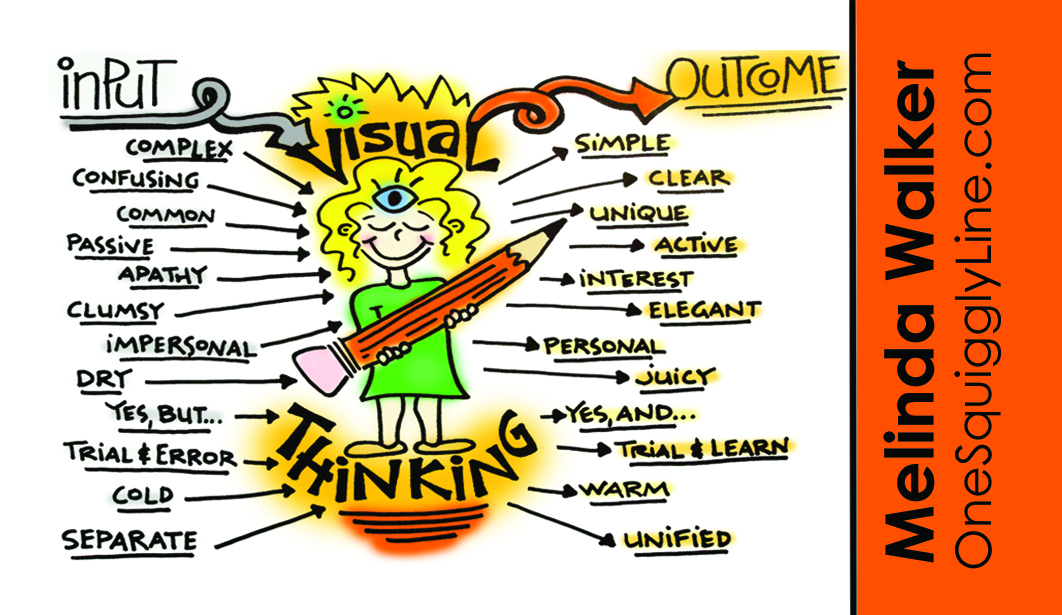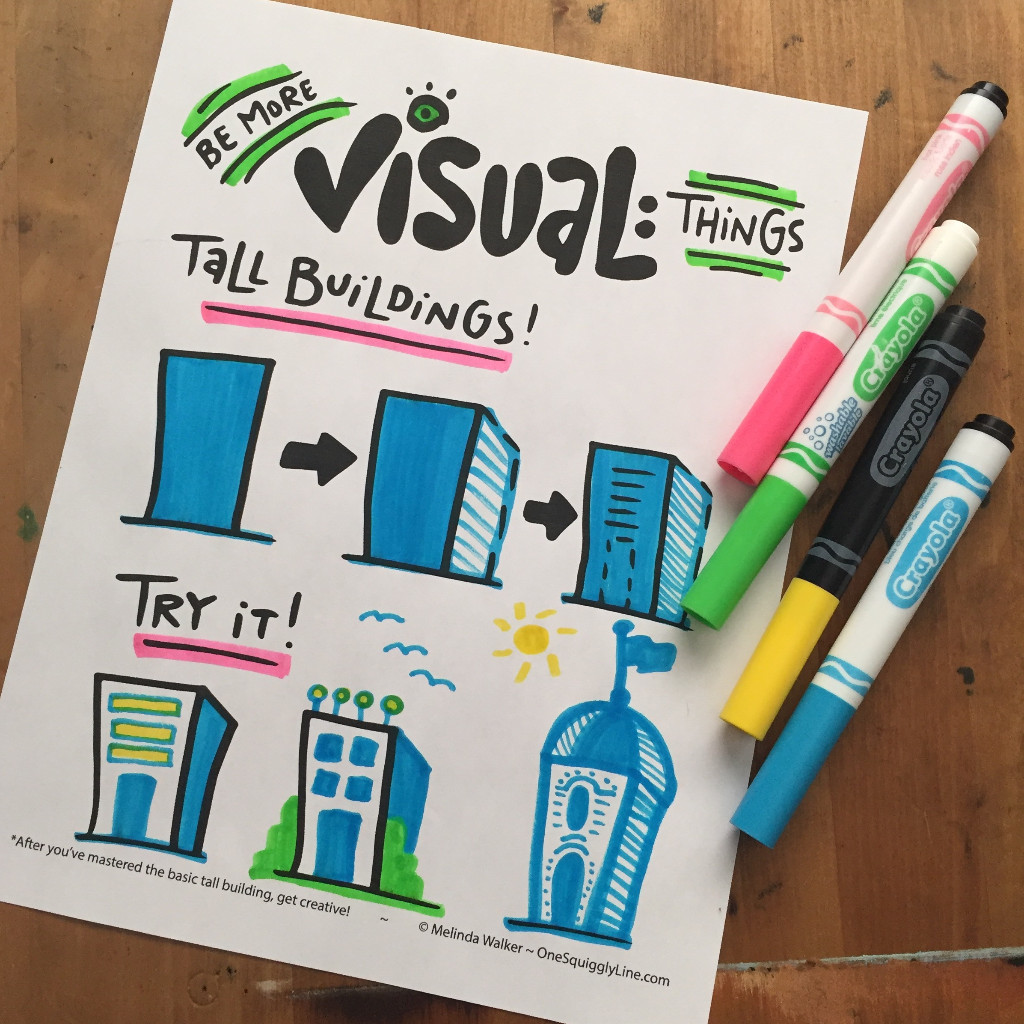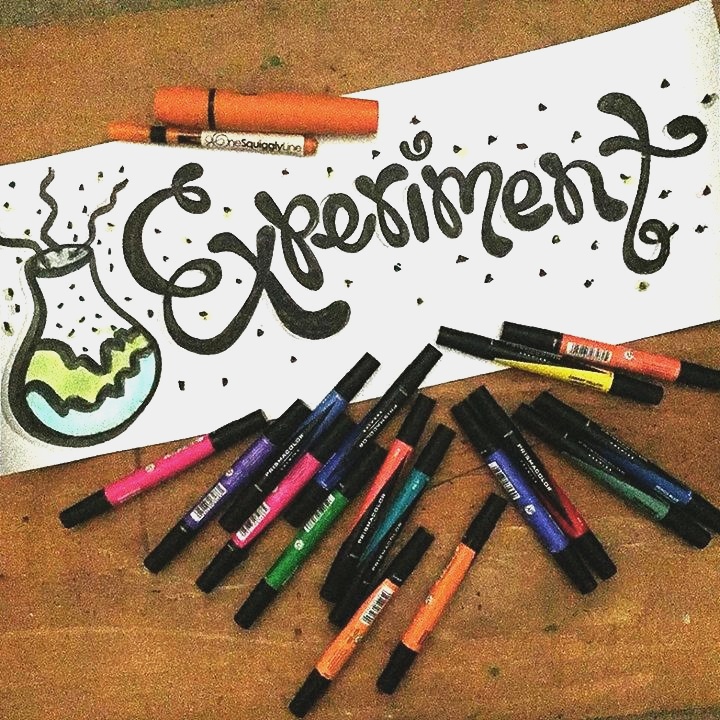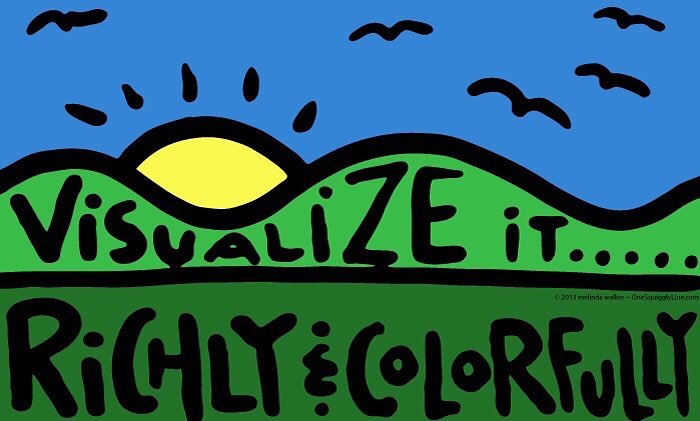What grabbed your attention first — the image above or the big chunk of text below?
Odds are, the image grabbed your eye first. It's probably the main reason you're reading the text in the first place! So go back to the image for a minute. Really look at it. READ it.
Now, read the paragraph below:
Visual thinking makes complex information simple, brings clarity to confusing communication, makes the common unique, turns the passive into the active and apathy into interest. With visual thinking, the clumsy becomes elegant, the impersonal becomes personal, the dry becomes juicy, "Yes, but..." is replaced with "Yes, and...", trial and error turns to trial and learn, the cold becomes warm, and the separate become unified.
That paragraph and the accompanying image say the same thing! Most people find the information easier to absorb through the image than the paragraph. They're able to absorb that information faster and remember it longer. And, it's a lot more fun!
Creativity: The Idea Box
There's a myth out there that highly creative people just sit around and wait for inspiration to strike. Like a great big lightening bolt from the sky. Or a soft whisper from a mystical muse.
Truth is, creativity is not quite so passive. It is an active process. And there's a science to it, not just an art. There are even formulas, methods, and procedures for generating ideas and, equally importantly, evaluating them.
One classic way to create something new is to combine things. And a great way to do that is with an idea box. It's really easy to do - the image above shows one I used with kindergarten through jr. highers.
First, write out the parts of your project, problem or whatever you're thinking about. Next, make a list of thing that fall into each of those categories (random is good here!). Then, chose something from each list and put them all together. If you don't like what you end up with, reach back into your idea box until you find something you do like!
Visual Thinking Words & Pictures Together
Hand-drawn visual created in real-time
increase an event's impact by:
allowing the audience to see what they just heard — increasing engagement and retention.
literally showing the audience the big picture of each talk and, when displayed together, the event as a whole. (Great for social media!)
providing a visual document of the day that can be shared during and after the fact...for years and years to come!
bringing underlying themes and patterns to the surface and deepening conversations.
piquing curiosity or spurring action when gaps in information or next steps become apparent.
Creativity: The 3 C's
Creativity researchers acknowledge there are different types of creativity and sometimes break it down like this:
Big C — Creative genius (think Einstein, da Vinci, etc.)
Little c — Every day creativity, like writing a witty text
Professional c — Those whose job it is to create (like me!)
While not everyone can be a big C or a professional c creative, everyone has plenty of little c creativity! Drawing is a great place to start for any kind of creativity. Check out my YouTube channel for some quick videos to get your creative juices flowing.
Check out One Squiggly Line's About Visual Thinking page to learn more about little c creativity.
Creativity: Creative Combinations
Creativity
There's a myth out there that highly creative people just sit around and wait for inspiration to strike. Like a great big lightening bolt from the sky. Or a soft whisper from a mystical muse.
Truth is, creativity is not quite so passive. It is an active process. And there's a science to it, not just an art. There are even formulas, methods, and procedures for generating ideas and, equally importantly, evaluating them.
One classic way to create something new is to combine two things. Take the markers above, for example. Nothing new about a round tip marker. Or a brush tip marker. But when you put them both in one pen, you end up with a whole new product!
Learn More About Visual Thinking
Visual Thinking: Simple is Powerful
Friendly hand-drawn visuals can breathe new life into an old message. The topic of New Year's resolutions has been covered time and time again. So much so that people stop really paying attention to it. In effect, it becomes invisible.
When that happens, a new approach is needed. Something to break the pattern and grab people's eye. No need to make it fancy or complex. Simple can be very powerful. Plus, when you keep things simple, they're less scary so you're more likely to follow through.
Creativity: You ARE Creative
Many people don't consider themselves creative because they can’t “draw” or “paint”.
The reality is that creativity can take on a variety of forms - many forms beyond the physical realm. In fact, creativity starts and is born from our internal world. Our goal is to figure out which medium best portrays our personal creativity.
Thus, we must make sure we cultivate an environment that is conducive to creativity. But how do we do that? How do we know what that environment looks like? Isn’t it different for everyone?
Yes.
The first step, and the most important step, is to become more familiar with ourselves.
We must be able to recognize the types of things that stir our heart, set our soul on fire, and make us come alive. Because once we recognize them, then we can begin to replicate them.
And the only way to find out is by trying out a variety of different things, as creativity demands quantity.
“Don’t ask what the world needs. Ask what makes you come alive, and go do it. Because what the world needs is people who have come alive.”
-Howard Thurman
Learn More About Visual Thinking
Creativity: 10 Ways to Shake Things Up!
Take a cold shower
This will likely be an unfamiliar experience, allowing you to create new neural connections.
Make a new meal without a recipe
This will force you to be comfortable without all of the answers in front of you
Try a new hairstyle
A new change could inspire you!
Create a new outfit that you’ve never worn before
Mixing and matching will help you form new styles. A new outfit can give you a new vibe, which can inspire confidence.
Journal about your day
This reflection time will allow you to absorb what you’ve learned throughout the day. Journaling will also allow you to look back on old memories and see patterns in your life.
Take a new route that you haven’t taken before
This will give you a new perspective. This will take you out of auto-pilot mode, and force you to think in different ways.
Rearrange your room or living space
This can create a fresh environment and get you out of a routine feeling
Ask more questions
The more curious you are, the more you will learn.
Limit or eliminate social media for a day
You can use the extra time gained from eliminating social media to be more productive. You can spend this time in silence. It will likely be an unfamiliar experience.
Exercise your body and mind
Whether working out, doing yoga or meditating, this will allow your body and mind to relax and take a break from life.
Giving your mind a break allows creative ideas to flow naturally.
Hire me to shake things up for you!
Visual Thinking & Creativity; Visualize it richly & colorfully
Visualizing things richly and colorfully leads to more creative thinking. You probably visualize things more than you realize, without really thinking about it. So you already have some visual thinking skills. But how do you become better at visualizing things on purpose?
Try this:
Go to a hardware store or someplace that sells paint. First, pick a paint sample color card that matches your shirt. That's a warm-up, starting with something very concrete and right in front of you — your shirt.
Then, look for a paint sample color card that matches something at home. It could be a different shirt, a piece of furniture, your walls. Whatever you choose, you will need to picture it very clearly in your mind so you can "see" the color.
Paint sample cards are usually free, so you can take home the ones you think are the closest and see how well you did. The more you practice, the better you get!
Check out One Squiggly Line's About Visual Thinking page to learn more.
Visual Thinking: Visual Biography
Abstract ideas can be fascinating, but our brains really prefer things to be concrete. That way, it's much easier for the brain to make sense of them. And remember them.
A great way to make your own short bio more memorable and engaging is to make it visual! Mine is above. As you can see, the key facts are worked into my logo. That helps folks remember a bit about me when they look at my logo, wherever it is.
A visual biography can be much more powerful than a paragraph or two listing your accomplishments. So if you need to give a quick bio for a speaking engagement or whatever, make it visual!
Check out One Squiggly Line's About Visual Thinking page to learn more.











